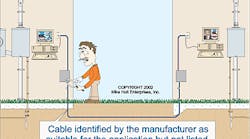Q.
Can I use listed low-voltage or limited-energy cables outdoors or underground?
A.
The NEC requires low-voltage and limited-energy wiring within buildings to be listed as resistant to the spread of fire (725.71, 760.31, 760.71, 770.49, 800.49, and 820.49). Because the NEC doesn't require low-voltage or limited-energy wiring used outdoors or underground to be listed, UL doesn't have a standard to list cables for these applications. Therefore, you can use any low-voltage or limited-energy wiring outdoors or underground that's approved by the AHJ (90.4 and 110.2) (Figure).
A.
There are no specific rules for outdoor fans, per se, but the general wiring methods of the Code still apply. The outlet box must be listed for the fan's weight [314.27(D)], the fan can't be installed in the shower or bathtub space as identified by 410.4(D), nor can it be installed within 5 ft of a pool, spa, or hot tub [680.22(B)]. The area under a covered deck would be a damp location (Art. 100), so be sure to use a fan approved by the AHJ (110.2).
The NEC doesn't require the ceiling fan to be listed, but if it is, then it must be installed in accordance with the listing instructions [110.3(B)].
Q.
Abandoned low-voltage and limited-energy cable is a big problem in my plant. Where in the NEC does it specify that this type of cable must be removed?
A.
The NEC rules that require the accessible portion of abandoned cables to be removed include 640.2 for sound systems, 725.3(B) for Class 2 and 3 circuits, 760.3(A) for fire alarm cables, 770.3(A) for optical fiber cables, 800.52(B) for communications cables, 820.3(A) for coaxial cables, and 830.3(A) for network-powered broadband communications cables.
Abandoned low-voltage and limited-energy cable is neither terminated at equipment nor identified for future use with a tag (640.2, 725.2, 760.2, 770.2, 800.2, 820.2, and 830.2).
Q.
An electrician told me that I couldn't use nonmetallic sheathed cable (Type NM) to wire a hot tub/spa at my one-family home. But the salesman at Home Depot said I could. Who's right?
A.
If the hot tub/spa is located indoors, then Type NM cable can be used as the wiring method (680.43). However, if the hot tub/spa is located outdoors, then Type NM cable can only be used for the indoor portion of the circuit [680.42(C)] and rigid nonmetallic conduit and liquid-tight flexible conduit would be required outside [680.42 and 680.42(A)].
Type NM cable isn't permitted as the wiring method to an underwater hot tub/spa light [680.23(F)(1)].
Q.
I have been asked to wire a baptismal unit that will be permanently built into the stage of a church. I have yet to find anything in the NEC that directly addresses this topic. Should I treat this as a pool, spa, or therapeutic tub?
A.
The NEC doesn't address this issue, so it's a judgment call for the authority having jurisdiction. I would consider it an indoor hot tub/spa and apply the requirements of Art. 680, Part IV.





